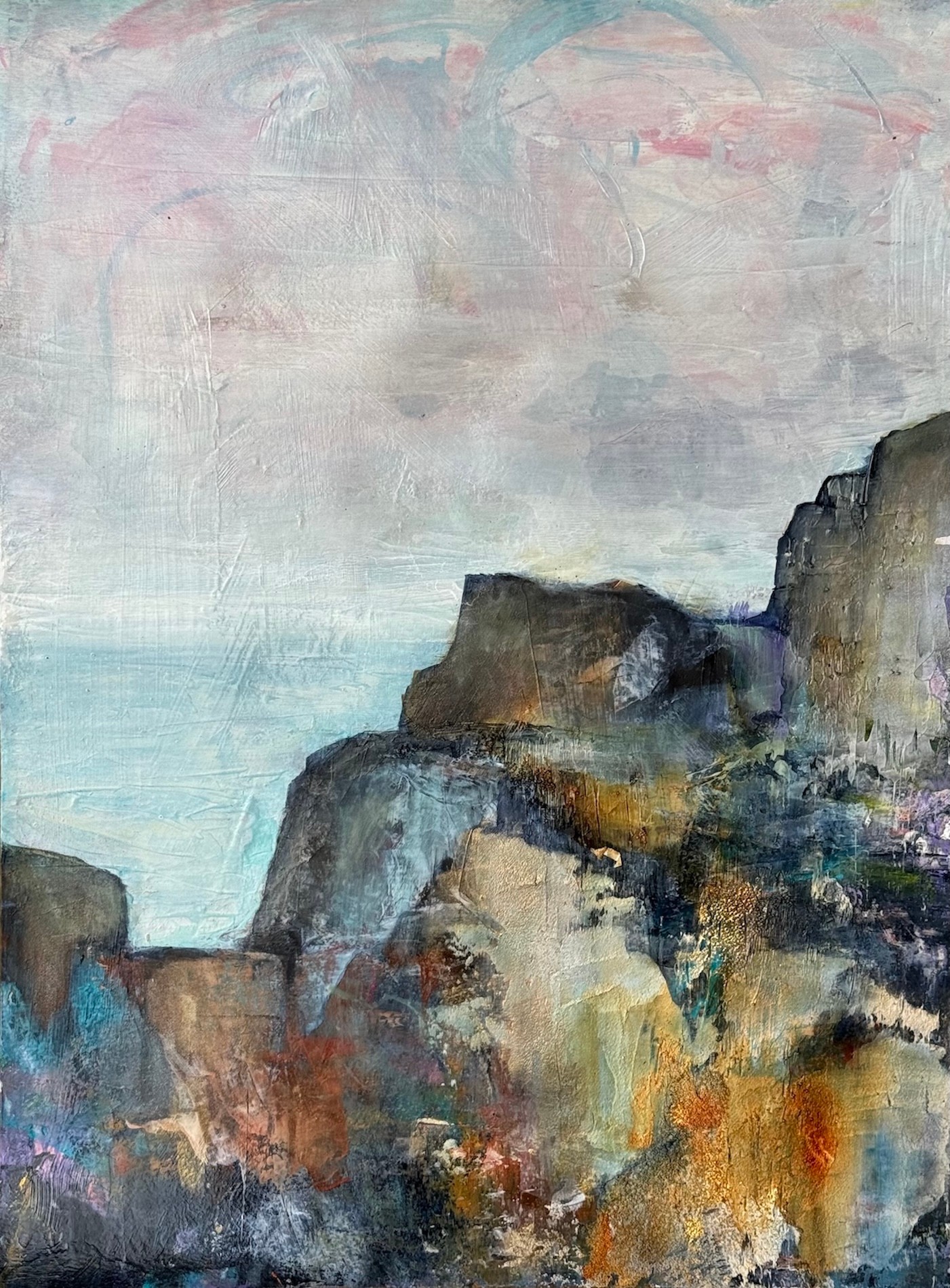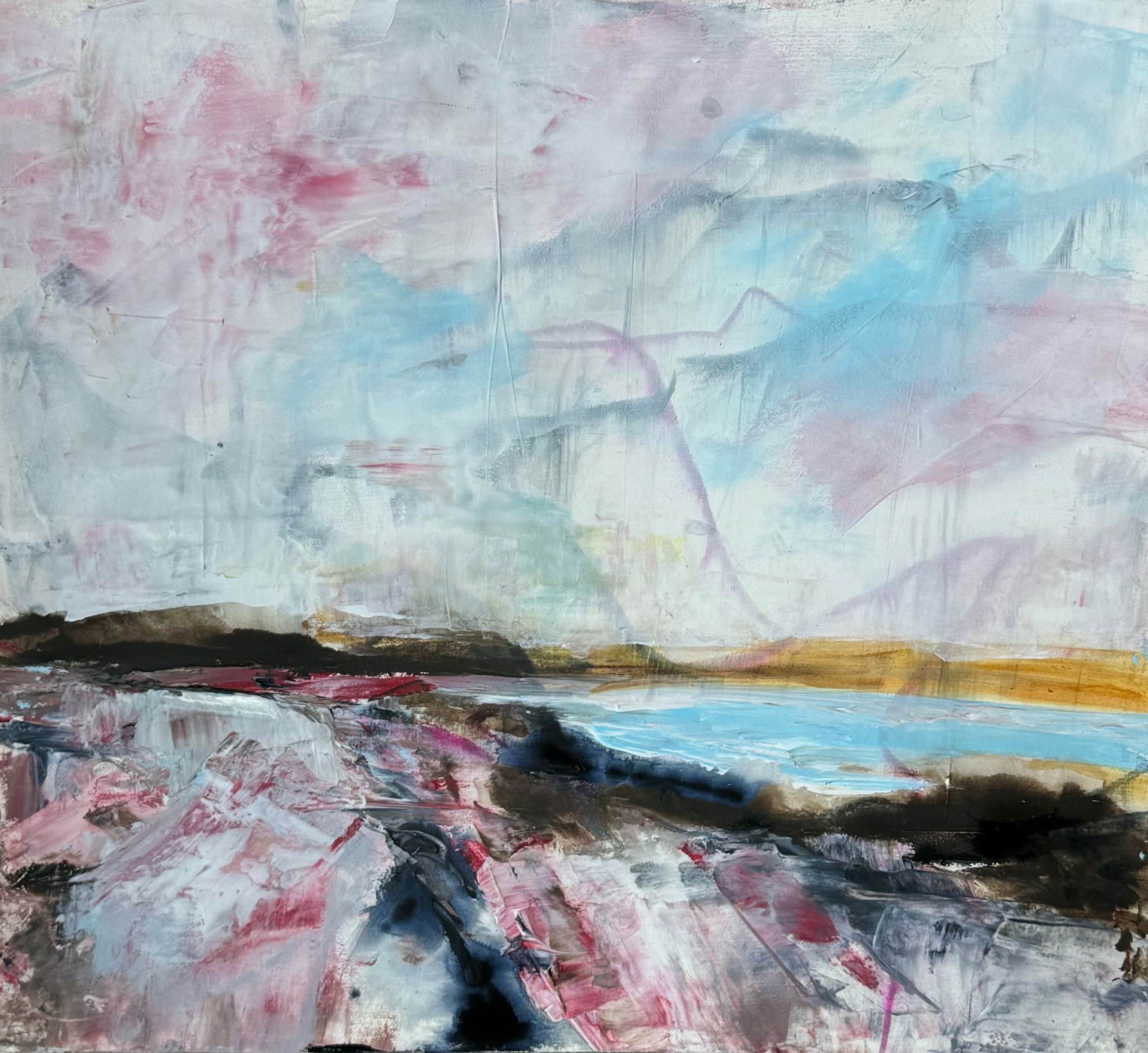Alright – so today we’ve got the honor of introducing you to Camille Kouyoumdjian. We think you’ll enjoy our conversation, we’ve shared it below.
Camille, thanks for joining us, excited to have you contributing your stories and insights. It’s always helpful to hear about times when someone’s had to take a risk – how did they think through the decision, why did they take the risk, and what ended up happening. We’d love to hear about a risk you’ve taken.
About 20 years ago, I took a significant creative and professional risk: I decided to leave the stability of a public service career in health policy to pursue my passion for art full-time. It was a leap into the unknown, especially because my art practice had always been a personal endeavor—a way to process the world, not necessarily to make a living. I wasn’t sure if I could sustain myself financially, much less build a successful career, but I felt deeply compelled to create work that captured the urgency of environmental sustainability.
The turning point came while I was volunteering as a Master Gardener and beekeeper. Spending time immersed in the natural world—planting pollinator gardens, studying the interdependence of ecosystems, and grappling with the tangible impacts of climate change—shifted my perspective. I realized that my art could serve as a bridge between my research background and my creative instincts, translating fieldwork into visual narratives that could resonate with a broader audience.
When I officially made the transition, the challenges came fast. Jurying into local shows and securing my first solo exhibition required hours of networking with art leagues and galleries, submitting proposals, and curating my portfolio —all while experimenting with new materials like fluid acrylics, cold wax, and upcycled collage. Balancing the business aspects of my practice, such as social media marketing, bookkeeping, and setting up studio space were daunting, and I often questioned whether I had made the right choice. Still, I pressed on, drawing strength from the idea that my work could spark conversations about conservation and sustainability.
The first gallery to feature my work in a solo exhibition was a small but well-respected space in Washington, DC. The exhibit featured a series of mixed-media landscapes inspired by local ecosystems. To my surprise, the opening night was packed, and viewers engaged deeply with the work. Some even shared their own stories of connection to the land, which I later wove into an evolving audio-visual installation. Seeing the impact my art had on others solidified my decision and gave me the confidence to keep going.
Since then, I’ve had the privilege of exhibiting in numerous galleries, both as a solo artist and as part of team of likeminded creatives. I’ve curating and juried shows that emphasize climate justice, creating spaces where art and activism intersect. Looking back, the risk was immense, but it was also necessary. It taught me that meaningful work often requires stepping into uncertainty—and that passion paired with persistence can lead to unexpected and rewarding outcomes.

Great, appreciate you sharing that with us. Before we ask you to share more of your insights, can you take a moment to introduce yourself and how you got to where you are today to our readers.
My work explores the dynamic interplay between nature and humanity. At a certain point in my journey, I realized I could use art to bridge science, advocacy, and creativity. That realization inspired me to take the leap into a full-time art practice.
I create mixed-media works that reflect nature’s cycles of chaos and renewal, using materials like acrylic texture media, oil mixed with cold wax, and upcycled materials. Each piece begins with extensive research into a location’s ecological and human history, drawing on my background in social science. My work often incorporates immersive textures and layers to evoke the complexity of ecosystems, and I design landscapes that encourage viewers to reflect on their own relationship with the environment. In galleries, my art is sometimes paired with an interactive audio-visual element, where viewers contribute their reflections or stories about nature, making the experience collaborative and personal.
What sets my work apart is this focus on storytelling and connection. My goal isn’t just to create beautiful art—it’s to spark conversations and inspire action. I want people to leave my exhibits thinking about their role in preserving the planet. This sense of purpose is what drives my work, and it’s what I’m most proud of. From curating climate justice exhibitions to collaborating with community groups, I’ve had the privilege of contributing to projects that combine creativity and advocacy in meaningful ways.
For those considering connecting with my work, I want them to know that it’s deeply rooted in both passion and research. Whether you’re drawn to the artistic details, the environmental message, or the interactive elements, my hope is that each piece offers a moment of reflection and inspires a sense of stewardship for the natural world. My art isn’t just about showcasing landscapes—it’s about fostering a shared commitment to protecting the planet we all call home.

What can society do to ensure an environment that’s helpful to artists and creatives?
Supporting artists and fostering a thriving creative ecosystem requires a multifaceted approach that values the arts as essential to society. Here’s what I believe society can do to best support artists and creatives:
1. Increase Public Funding for the Arts
Governments, nonprofits, and private institutions should expand grants, fellowships, and public arts programs. Many artists rely on these resources to fund projects, access studio space, or exhibit their work. Public investment in the arts creates opportunities for creatives at all stages of their careers and ensures diverse voices are heard.
2. Integrate Art into Education
Arts education should be a priority at every level, from primary school to adult learning. By integrating art into curricula, we can nurture creativity, critical thinking, and cultural appreciation. Early exposure helps young people see creative careers as viable and valuable.
3. Provide Accessible Spaces for Creation and Exhibition
Affordable studio spaces, galleries, and performance venues are critical for artists to practice and share their work. Community-based spaces that are open to artists of all backgrounds and income levels foster collaboration and innovation.
4. Promote Fair Pay and Recognition
Too often, artists are asked to work for “exposure” or undervalued compared to other professions. Establishing fair pay standards for creative work ensures that artists can sustain themselves financially while pursuing their craft.
5. Support Local Artists and Artisans
Buying local art, attending shows, and commissioning work from local creatives are tangible ways individuals can support their communities. Local governments and businesses can also prioritize working with regional artists for public projects, events, and branding.
6. Encourage Collaboration Between Sectors
Partnerships between artists and other industries—like technology, environmental science, or urban planning—can lead to innovative projects with wide-reaching impact. These collaborations highlight how creativity enriches every field.
7. Cultivate an Appreciation for Diverse Perspectives
A thriving creative ecosystem values voices from all backgrounds, cultures, and experiences. Society must address systemic barriers—such as inequities in access to funding, education, and representation—that limit participation in the arts.
8. Advocate for Art in Everyday Life
Public art installations, live performances in community spaces, and creative events bring art to people who might not otherwise engage with it. Integrating art into daily life helps society see its value as more than a luxury—it’s a necessity for cultural and emotional well-being.
9. Leverage Technology to Expand Reach
Digital platforms can help artists share their work with global audiences, but these tools must be accessible and equitable. Supporting initiatives that train artists in digital skills and ensure affordable access to technology can help creatives thrive in a digital age.
10. Celebrate Artists as Change-Makers
Artists often lead cultural and social movements, using their work to challenge norms and inspire action. Society should recognize and celebrate the role of creatives in shaping progress, fostering empathy, and envisioning better futures.
By addressing these areas, society can create an environment where artists and creativity flourish, enriching communities and inspiring innovation across every aspect of life.

Looking back, are there any resources you wish you knew about earlier in your creative journey?
Absolutely! Looking back, there are several resources I wish I had discovered earlier in my creative journey. These resources would have saved time, reduced frustration, and opened doors to new opportunities. Here’s what I would recommend to anyone starting out:
Grants and Funding Opportunities
Early in my career, I didn’t realize how many grants and funding programs existed specifically for emerging artists. Platforms like ArtPlace America, Creative Capital, and local arts councils offer financial support for projects, but I discovered them much later than I wish I had.
Online Learning Platforms
Platforms like Skillshare, Domestika, and Coursera offer affordable courses taught by experts. Learning techniques in mixed media, cold wax, and digital tools through these could have accelerated my experimentation process.
Community Arts Organizations
Joining organizations like local art leagues, juried galleries, or groups such as the National Association of Women Artists provides networking, exhibition opportunities, and mentorship.
Social Media as a Tool
Utilizing the power of platforms like Instagram, YouTube and Pinterest for building an audience, sharing work, and networking.
Critique Groups and Mentorships
Joining critique groups or mentorship programs like those offered by art schools, nonprofits, or online forums is crucial for growth. Receiving constructive feedback and connecting with mentors can provide invaluable guidance.
Local Small Business Resources
Many local chambers of commerce and nonprofits offer free or low-cost resources for entrepreneurs, including artists. I discovered workshops on marketing, taxes, and grant writing that really helped. .
If I had known about these resources earlier, I could have spent more time focusing on creative exploration and less time struggling to figure out logistics. For emerging artists, I recommend researching these tools early and not being afraid to ask for help or advice from other creatives—they’re often the best resources of all!
Contact Info:
- Website: https://www.wildhorizonfineart.com/
- Instagram: https://www.instagram.com/wildhorizonfineart/
- Facebook: Wild horizon, fine art by Camille Kouyoumdjian
- Linkedin: Camille Kouyoumdjian








